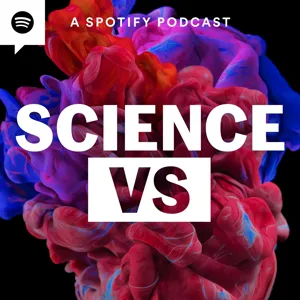Podcast Summary
Exploring the Impact of Guns on Society through Science: The Science Versus podcast challenges the gun lobby's narrative that guns keep us safe, instead focusing on the scientific evidence of gun usage's effects on individuals and communities. From New Jersey gun ranges to the long-term consequences, this episode sheds light on the complex role of guns in society.
The podcast "Ologies" hosted by Allie Ward offers an engaging exploration into various scientific fields, from etymology to neuroparasitology. Meanwhile, on Science Versus, the episode about guns challenges the perception that guns keep us safe, as presented by the gun lobby. Instead, the episode delves into the reality of gun usage and its impact on communities. At Gun For Hire in New Jersey, owner Anthony Calantro debunks the stereotype of gun range attendees as Duck Dynasty characters. Instead, the demographic is more diverse than one might assume. However, the focus of this episode shifts from personal experiences to the scientific evidence regarding gun usage and its effects on society. The first part of this two-part series aims to answer the following questions: 1. How many times a year are guns used for good? 2. What are the long-term effects of gun ownership on individuals and communities? Stay tuned for more insights into the role of guns in society from a scientific perspective.
Gun ownership for self-defense: Approx. 300M guns in US, half owned for protection, 2.5M defensive uses yearly, validity debated
An estimated 300 million guns exist in the US, primarily owned for self-defense. The National Rifle Association promotes the belief that having a gun can protect individuals from harm. According to a Pew survey, almost half of gun owners cite protection as their primary reason for owning one. The number of defensive gun uses is estimated to be around 2.5 million per year, based on a study by Gary Kleck. However, the validity and accuracy of this number are subject to debate. Despite this, the belief in the need for self-defense remains a significant factor in the gun ownership debate.
Extrapolating small sample sizes can lead to inaccurate results: Small sample sizes can result in erroneous conclusions when extrapolated to larger populations
Extrapolating small sample sizes to large populations can lead to significantly inaccurate results, as Professor David Hemenway of Harvard University cautions. This issue was raised in relation to a study claiming that 1.3% of Americans use guns defensively each year, which, if extrapolated to the entire adult population, would equate to a large number. However, this method is unreliable and can result in erroneous conclusions, as small mistakes or misreporting can have significant impacts on the final figure. For instance, a study on virgin births among women in the US yielded a similarly small percentage, but extrapolating it to the population would result in a massive error. Therefore, it's crucial to rely on larger, more reliable surveys, such as the National Crime Victimisation Survey, which interviews around 90,000 people and is considered the gold standard in this field.
Defensive gun uses in the US are less common than believed: Though defensive gun uses occur, their frequency is much lower than reported, and the effectiveness is debatable. Most gun deaths are suicides, and accidental or mass shootings are rare.
The number of defensive gun uses in the US is much smaller than often reported, around 100,000 per year. Additionally, the effectiveness of using a gun for self-defense is debatable and may not be more effective than other methods. It's important to consider the potential harm caused by guns alongside these small benefits. The majority of gun deaths in America are actually due to suicides, making up around two-thirds of the annual total. Furthermore, accidental deaths and mass shootings, while tragic, are rare compared to the overall number of gun deaths and injuries.
Impact of means on suicide rates: Restricting access to deadly means can delay impulsive suicide attempts, increasing the chances of survival.
The availability of certain means significantly impacts suicide rates. The theory of substitution suggests that if one method of suicide is removed, people may simply choose another. However, research on means restriction, such as the banning of pesticides in Sri Lanka and gun restrictions in Australia, shows that fewer suicides occur when deadly means are unavailable. This is because most suicides are impulsive acts, and removing the means can delay the act long enough for the person to reconsider or seek help. Contrary to some arguments, time does matter in suicide prevention. The longer a person can be delayed from making a suicide attempt, the more likely they are to survive. Therefore, restricting access to deadly means is an effective strategy for suicide prevention.
Gun ownership and crime: Complex relationship: Studies show the relationship between gun ownership and crime rates is complex and not always clear-cut, with concealed carry laws not necessarily leading to a decrease in crime
The presence of guns does not necessarily reduce crime. While some argue that law-abiding citizens carrying guns can deter criminals, studies have shown that the relationship between gun ownership and crime rates is complex and not always clear-cut. For instance, the claim that concealed carry laws lead to a decrease in crime has been debunked by many researchers. It's important to remember that this is a complex issue with many nuances, and it's crucial to consider multiple perspectives and reliable sources of information when forming an opinion. Now, let's shift gears and talk about something completely different - the amazing southern sand octopuses! These clever creatures create underwater homes using their mucus and build chimneys for ventilation. It's fascinating how nature inspires us with its ingenuity. So, take a break from heavy topics and enjoy the wonders of the world around us.
The relationship between guns and crime: Despite common belief, more guns don't lead to less crime overall. Guns do impact homicide rates, making hostile interactions more deadly.
The presence or number of guns in a population does not have a significant impact on the overall crime rate. This conclusion comes from a study conducted by a team of scientists, including David Hemingway, who spent three years investigating the mysterious decline in crime rates around the world in the late 1990s. Despite the common belief that more guns lead to less crime, the data does not support this notion. For instance, there are states in the US with high gun ownership rates but low crime rates, such as Montana, and states with high crime rates but also high gun ownership, like Alaska. Additionally, the crime rate in the US, which has more guns than any other high-income country, is just average. The study also found that guns do have an impact on one specific type of crime: homicide. Guns make hostile interactions more deadly, leading to a higher likelihood of fatalities. In the US, approximately 11,000 homicides occur each year, and about 64% of those are gun-related. However, it's important to note that there are exceptions, as some states with high gun ownership rates have low homicide rates. For example, Idaho.
The more guns in a state, the higher the rate of female firearm-related murders.: Guns increase the likelihood and deadliness of female homicides, making them a significant contributor to the issue.
The correlation between guns and female homicides is clear-cut. A study found that the more guns in a state, the higher the rate of female firearm-related murders. This is likely due to the fact that women are more likely to be killed by someone they know, and the availability of guns in these situations can make a deadly situation even more fatal. However, it's important to note that guns do not affect the overall crime rate, but they do make crimes more deadly. Despite this scientific evidence, there is a debate around guns due to personal experiences and biases. People may feel safe with their guns and believe that they are not contributing to the problem, but the science tells us that the more guns there are, the more people die.
Gun Control and Crime Rates: Debunking Myths: Despite common belief, stricter gun control measures in the UK led to an increase in handgun crime, challenging the notion that such laws reduce violence.
Learning from this episode of Science Versus is the ongoing debate between science and guns in America. The show explored the relationship between gun ownership and crime rates, focusing on the UK's experience with handgun control. Contrary to popular belief, handgun crime actually doubled in Britain after strict gun control measures were implemented. The discussion also touched upon the scientific evidence regarding gun control and its impact on saving lives. In the upcoming episode, Science Versus will dive deeper into this topic, examining the facts and debunking common myths about gun control. Stay tuned for part 2 of this intriguing series.





